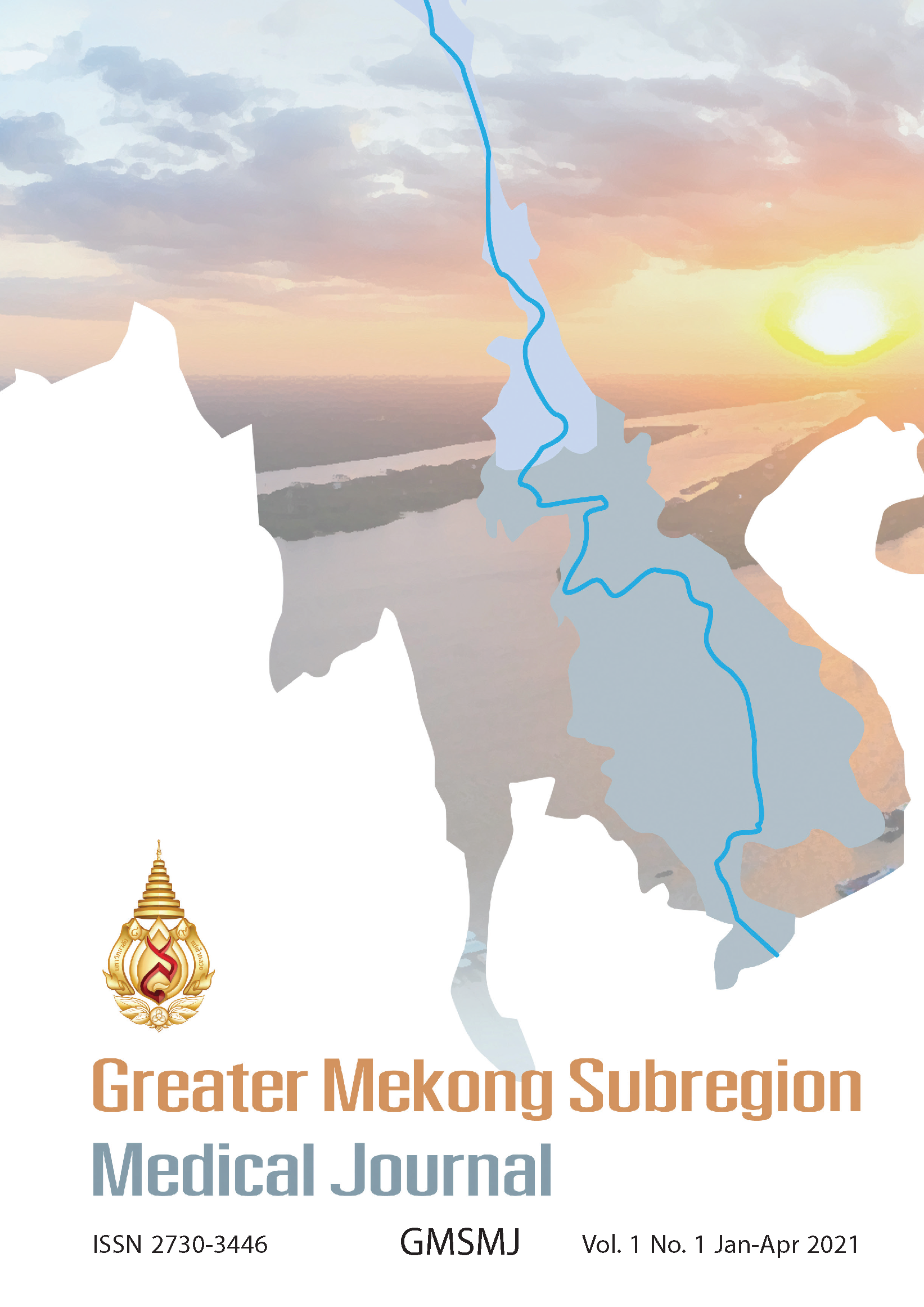Nutritional Values of the Gelatinous Substance in Bamboo Internodes
Keywords:
Gelatinous substance, Dendrocalamus strictus, Nutritional valuesAbstract
Background: During the rainy and cool seasons, internodes of bamboo (Dendrocalamus strictus) contain a clear light brown gelatinous substance with a pale bamboo odor. This gelatinous substance is traditionally called “Piang” and has long been used as a food by northern Thai people. However, there have been no reports regarding nutritional values to support the promotion of this local wisdom usage.
Objective: Thus study aimed to evaluate the nutritional values and anti-oxidant properties of this gelatinous substance.
Methods: Bamboo gelatinous substance was collected from local markets in Chiang Rai, freeze dried and subjected to nutritional analysis and anti-oxidant assay.
Results: The results showed that 1.0 gram of dried gelatinous substance contains 0.79 g of insoluble dietary fiber and 0.11 g of soluble dietary fiber. There was 0.16 g of protein in 100 grams of fresh gelatinous substance and no fats or sugars were detected. Silicon was the most predominant mineral found in the bamboo gelatinous substance. Its content was 20 mg/100 g fresh gelatinous weight. Other minerals found in 100 g fresh gelatinous substance were potassium (104 mg), sodium (2 mg), magnesium (1.78 mg), calcium (4 mg), phosphorus (8 mg), iron (0.14 mg), zinc (0.04 mg) and chloride (4.40 mg). Total polyphenols at small concentrations were found but no anti-oxidant properties were detected.
Conclusion: All of these findings suggested that bamboo gelatinous substance contains almost zero calories but is rich in dietary fibre and silicon, both of which are beneficial to health. This natural product could be developed as a potential dietary supplement.
References
Choudhury, D., Sahu, J.K., & Sharma, G.D. Biochemistry of Bitterness in Bamboo Shoots. Assam University Journal of Science &Technology: Phys Sci Technol 2010; 6 (2): 105-11.
Lattimer, J.M., & Haub, M.D. Effects of Dietary Fiber and Its Components on Metabolic Health. Nutrients 2010; 2 (12):1266–89.
Dhingra, D., Michael, M., Rajput, H., & Patil, R.T. Dietary fibre in foods: a review. J Food Sci Technol 2012; 49 (3): 255–66.
Dransfield, S. Forest Bamboo in Key Environments. Malaysia:1988.
AOAC. Official Methods of Analysis. 20th. ed. Maryland: AOAC International, Gaithersburg, 2016.
Kolthoff, I.M., Sandell, E.B., Meehan, E.J. & Bruckenstein, S. Quantitative Chemical Analysis. New York: Macmillan; 1969.
Lu, J., Zhao, H., Chen, J., Fan, W., Dong, J., Kong, W., Sun, J., Cao, Y., & Cai, G. Evolution of Phenolic Compounds and Antioxidant Activity During Malting. J Agri Food Chem 2007; 55 (26): 10994-1001.
Benzie, I.F., & Strain, J.J. The Ferric Reducing Ability of Plasma (FRAP) as a Measure of “Antioxidant Power”: The FRAP Assay. Anal Biochem 1996; 15; 239 (1):70-6.
Katsube, T., Tabata, H., Ohta, Y., Yamasaki, Y., Anuurad, E., Shiwaku, K., & Yamane, Y. Screening for Antioxidant Activity in Edible Plant Products: Comparison of Low-Density Lipoprotein Oxidation Assay, DPPH Radical Scavenging Assay, and Folin−Ciocalteu Assay. J Agri Food Chem 2004; 52 (8): 2391-96.
Lai, L.S., & Yang, D.H. (2007). Rheological properties of the hot-water extracted polysaccharides in Ling-Zhi (Ganoderma lucidum). Food Hydrocolloid 2007; s, 21(5-6): 739-46.
Jeong, S.C., Koyyalamudi, S.R., Jeong, Y.T., Song, C.H., & Pang, G. Macrophage immunomodulating and antitumor activities of polysaccharides isolated from Agaricus bisporus white button mushrooms. J Med Food 2012; 15 (1): 58-65.
Bureau of Nutrition. Dietary Intake Reference for Thais 2020. Bureau of Nutrition. Department of Health, Ministry of Public Health.
WHO Guideline: Potassium intake for adults and children. Geneva. World Health Organization 2012.
Pennington, J.A.T. Silicon in foods and diets. Food Add Contaminants 1991; 8: 97–118.
Jugdaohsingh, R., Anderson, S.H., Tucker, K.L., Elliott, H., Kiel, D.P., Thompson, R.P.H., & Powell, J.J. Dietary silicon intake and absorption. Am J Clin Nutr 2002; 75: 887–93.
McNaughton, S.A., Bolton-Smith, C., Mishra, G.D., Jugdaohsingh, R., & Powell, J.J. Dietary silicon intake in post-menopausal women. Brit J Nutr 2005; 94 (5): 813–17.
Sangster, A.G., & Hodson, M.J. Silica in higher plants. In: D. Evered & M. O’Connor M (Eds), Silicon Biochemistry, Ciba Foundation Symposium (Vol.121). West Sussex: John Wiley and Sons Ltd. Chichester; 1986. pp. 90–111.
Carlisle E.M. Silicon: an essential element for the chick. Science 1972; 178: 619.
Schwarz, K., & Milne, D.B. Growth promoting effects of silicon in rats. Nature 1972; 239: 333–4.
Jugdaohsingh, R. Silicon and bone health. J Nutr Health Aging 2007: 11(2): 99–110.
Nielsen, F.H. Update on the possible nutritional importance of silicon. J Trace Elements Med Biol 2014; 28 (4): 379-82.
Lunn, J. & Buttriss, J.L. Carbohydrates and dietary fibre. Nutr Bulletin 2007; 32: 21-64.
Asp, N.G. Dietary fibre-definition, chemistry and analytical determination. Mol Asp Med 1987; 9 (1): 17-29.
Southgate, D.A.T. Definitions and terminology of dietary fiber. In G.V. Vahouny & D. Kritchevsky (Eds), Dietary Fiber in Health and Disease. New York: Plenum Press; 1982, pp. 1-7.
Wisker, E., Daniel, M., & Felddheim, W. Particle size of whole meal rye bread does not affect the digestibility of macronutrients and non-starch polysaccharides and the energy value of dietary fiber in humans. J Sci Food Agri 1996; 70: 327–33.






